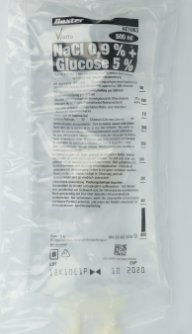
(BAXTER) Sodium Chloride 0.9% w/v & Glucose 5% Price
Active Substance: Glucose Monohydate, Sodium chloride.
Overview
Welcome to Dwaey, specifically on (BAXTER) Sodium Chloride 0.9% w/v & Glucose 5% page.
This medicine contains an important and useful components, as it consists of
Glucose Monohydate, Sodium chlorideis available in the market in concentration
Name
Glucose Monohydate, Sodium chloride
Precaution
<p>This solution is indicated for intravenous fluid replacement, rehydration, and as a source of energy and electrolytes in patients with fluid and electrolyte imbalance or caloric deficiency. It is commonly used in treating dehydration, hypotonic fluid loss, and to restore plasma volume. Additionally, it may serve as a vehicle for other compatible intravenous medications or for parenteral nutrition support.</p>
Indication
<p>Use with caution in patients with diabetes mellitus, renal impairment, cardiac dysfunction, or conditions associated with sodium retention such as hypertension or congestive heart failure. Regular monitoring of blood glucose levels, serum electrolytes, and fluid balance is advised, especially in patients receiving prolonged or high-volume infusions. Avoid extravasation and administer with aseptic technique to prevent infections or complications at the infusion site.</p>
Contra indication
<p>Contraindicated in patients with known hypersensitivity to glucose or sodium chloride components, severe hyperglycemia, hypernatremia, fluid retention states (e.g., pulmonary edema), or severe renal impairment where fluid overload may occur. It should not be administered in patients with uncompensated diabetes or those with anuria.</p>
Side Effect
<p>Common side effects may include local infusion site reactions such as pain, phlebitis, or erythema. Systemic side effects include hyperglycemia, electrolyte imbalance (especially hypernatremia or hypokalemia), fluid overload, and, in rare cases, pulmonary edema or congestive heart failure in susceptible individuals. Allergic reactions are rare but possible.</p>
Pregnancy Category ID
Information not available
Mode of Action
<p>Glucose monohydrate provides a source of calories and energy through its metabolism into carbon dioxide and water. Sodium chloride helps maintain extracellular fluid volume and osmotic balance. Together, they restore both energy and electrolyte equilibrium in patients experiencing dehydration, metabolic imbalances, or caloric deficit.</p>
Interaction
<p>May interact with corticosteroids, diuretics, or other agents that affect sodium and fluid balance. Concomitant use with insulin may be necessary to control hyperglycemia. Additive effects may occur when combined with other sodium-containing or glucose-containing solutions, necessitating careful monitoring to avoid fluid overload or electrolyte disturbances.</p>
Pregnancy Category Note
<p>This combination is generally considered safe during pregnancy when used appropriately for rehydration or nutritional support. However, careful monitoring is required to prevent hyperglycemia or fluid overload, which can adversely affect both the mother and fetus. Classified as Pregnancy Category C – use only if clearly needed and under medical supervision.</p>
Adult Dose
<p>The dose depends on the clinical condition, age, and weight of the patient, and the severity of the fluid or electrolyte deficit. Typically, 500 ml to 1000 ml may be administered intravenously over several hours. Dosage should be adjusted based on electrolyte status and fluid requirements.</p>
Child Dose
<p>Pediatric dosing must be individualized. A general guideline is 20 to 100 ml/kg/day based on body weight and clinical status. Frequent monitoring of fluid and electrolyte balance is essential to avoid complications.</p>
Renal Dose
<p>In patients with renal impairment, the dose must be adjusted to avoid fluid retention, hypernatremia, or hypervolemia. Monitoring of renal function, serum sodium, and fluid balance is essential, and alternative formulations may be required in advanced renal dysfunction.</p>
Administration
<p>Administer via intravenous infusion using a sterile, non-pyrogenic technique. The solution should be visually inspected for particulate matter and discoloration before administration. It may be given peripherally or centrally depending on osmolarity and clinical condition. Infuse slowly to avoid hyperglycemia or circulatory overload, and monitor patient response throughout therapy.</p>
